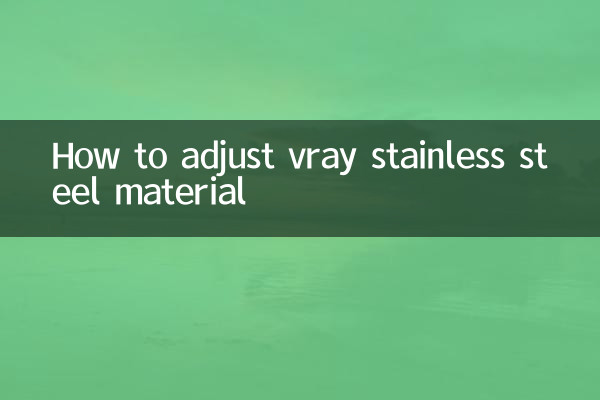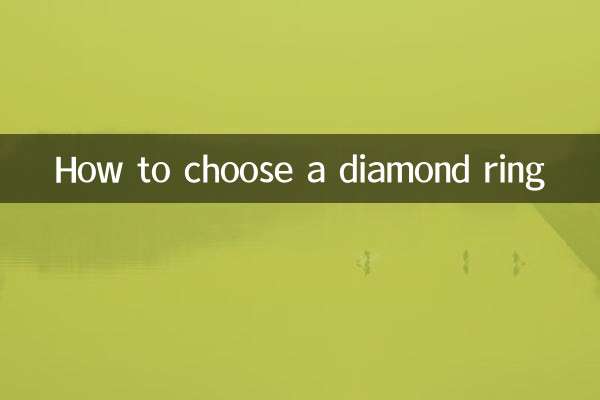How to adjust VRay stainless steel material
In 3D rendering, the performance of stainless steel materials is the focus of many designers and artists. VRay, as the industry's leading rendering engine, provides powerful material adjustment functions. This article will introduce in detail how to adjust VRay stainless steel material, and attach structured data to help you quickly master the skills.
1. Basic characteristics of stainless steel materials

Stainless steel material has high reflection, low diffuse reflection and obvious environment mapping properties. In VRay, you need to pay attention to the following key parameters when adjusting the stainless steel material:
| parameter | Recommended value | illustrate |
|---|---|---|
| Reflection color | RGB(180, 180, 180) | Gray near white, controls reflection intensity |
| reflective gloss | 0.7-0.9 | The higher the value, the clearer the reflection |
| Fresnel reflection | turn on | Simulate real-world reflection attenuation |
| Bump map | on demand | Add subtle textures to enhance realism |
2. VRay stainless steel material adjustment steps
1.Create VRayMtl material: Create a new VRayMtl shader ball in the material editor.
2.Set diffuse color: Set the diffuse reflection color to dark gray (RGB(50, 50, 50)) because stainless steel has weak diffuse reflection.
3.Adjust reflection parameters: Set the reflection color to light gray (RGB(180, 180, 180)) and check the Fresnel reflection option.
4.Adjust reflective gloss: Adjust the reflective gloss according to your needs. Values between 0.7-0.9 can simulate different degrees of frosted effects.
5.Add bump map: If you need to express wear or scratches, you can add a suitable map to the bump channel.
| Material type | reflective gloss | Applicable scenarios |
|---|---|---|
| Mirror stainless steel | 0.95-1.0 | High finish surface |
| brushed stainless steel | 0.6-0.8 | industrial equipment |
| brushed stainless steel | 0.7+ bump map | decorative materials |
3. Environment setting skills
The performance of stainless steel materials is highly dependent on environmental reflections. It is recommended to use HDRI environment maps or set up a rich reflection environment. Here are some recommended parameters for environment setup:
| environment type | strength | Effect |
|---|---|---|
| HDRI sky | 1.0-1.5 | natural environment reflection |
| light array | 0.8-1.2 | Precise control of highlight position |
| Reflective board | as needed | Strengthen reflections in specific areas |
4. Frequently Asked Questions and Solutions
1.Stainless steel looks like plastic: Usually it is because the reflection intensity is not enough or the Fresnel reflection is not turned on. Check that the reflection color is bright enough and make sure the Fresnel Reflection option is checked.
2.Reflection is too blurry: Appropriately increase the reflection gloss value, above 0.85, you can get a clearer reflection effect.
3.lack of details: Try adding a subtle bump map or noise map to increase surface detail.
4.Color is not accurate: Stainless steel is not completely colorless, the tint of the reflected color can be slightly adjusted, adding a small amount of blue or green.
5. Advanced skills
1.Mixed materials: Mix stainless steel with other materials to create more complex effects, such as stained or oxidized stainless steel.
2.Using VRayBlendMtl: The effect of surface coating can be simulated by mixing materials.
3.Procedural maps: Use program maps such as VRayDirt or VRayEdgesTex to automatically generate edge wear effects.
4.Animation effects: By controlling material parameters through key frames, you can create the effect of material changes over time.
Through the above methods and techniques, you can create realistic stainless steel materials in VRay. Remember, the performance of a material depends not only on parameter settings, but also on the scene lighting and environment. More practice and more observation of stainless steel materials in the real world will help you obtain better rendering effects.

check the details

check the details